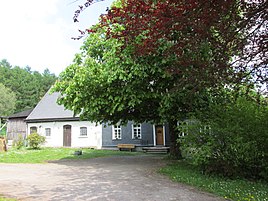Hermitage (Lennestadt)
|
hermitage
City of Lennestadt
Coordinates: 51 ° 3 ′ 56 ″ N , 7 ° 59 ′ 2 ″ E
|
||
|---|---|---|
| Height : | 548 m above sea level NHN | |
| Residents : | 5 (Jun 30, 2020) | |
| Postal code : | 57368 | |
|
Location of the hermitage in Lennestadt |
||
|
Old forester's house hermitage
|
||
Einsiedelei (better known today as Altes Forsthaus Einsiedelei ) is a district of the town of Lennestadt in the Olpe district in North Rhine-Westphalia .
location
The district of Einsiedelei is located in the extreme southwest of the city of Lennestadt in a wooded area. The car park above the Einsiedelei forester's lodge can be reached via federal road 55 (branch northeast of Oberveischede ) and federal road 517 (branch northeast of Welschen Ennest ). Nearby villages are Oberveischede and Bilstein .
Hermitage is located in the eastern area of 295.85 ha large nature reserve beech and swamp forests in Hermitage and Apollo Micke .
history
The history of the hermitage goes back to the 18th century. On April 17, 1731, Elector Clemens August von Bayern (from 1723 to 1761 as Clemens August I Archbishop of Cologne) gave the hermit August Risse permission to " sample a little clause in the forest on the Sundern or Wolfhardt belonging to the electoral rentier" To have chapels built in honor of God and St. John Nepomuceni, to be able to collect some alms for his maintenance in the Bilstein office and to have the rent master in Bilstein order the necessary wood. "
In the following years the number of hermits increased; Efforts were also made to have religious services held in the hermitage by religious priests. There were also allegations that the hermits ran a lucrative begging business and made an abundance of it. The neighboring parishes and especially the Franciscan monastery at Attendorn , who feared that donations would be lost , resisted this development . At the beginning of June 1788, guidelines for hermits were created by the responsible bodies and, for the purpose of better supervision, Pastor M. Ludolf Herold zu Hoynkhausen was entrusted with the supervision of the hermits. Nothing more was known of the hermitage until the secularization in 1803.
At the time of secularization, which also led to the dissolution of church institutions and the expropriation of their property in the Olpe district, three hermits of older age still lived in the hermitage. The Ministry in Darmstadt (the Olpe district belonged to the Grand Duchy of Hesse-Darmstadt from 1803 to 1816) ordered that the hermits should not be expelled until they died. The auction date of the hermitage could therefore only be announced on July 31, 1810. The valuable property comprised 8 living rooms and 1 cellar, as well as 1 chapel, 1 small stable and 1 bakery; in April 1811 the objects were handed over to the chief forester Götz in Ewig. The inventory auction also met with great interest.
At the end of June 2020, five people lived at the site of the old hermitage. The surrounding area is characterized by beech forests with diverse species of plants and animals. The hermitage is therefore a popular destination for hikers and nature lovers.
Individual evidence
- ↑ cf. Theo Hundt: The Klusen in the Olpe district , in particular the hermitage near Oberveischede and its closure in the course of secularization, in: Heimatstimmen aus dem Kreis Olpe, 56th episode (1964), p. 107.
- ^ Theo Hundt: Die Klusen in the Olpe district , in particular the hermitage near Oberveischede and its closure in the course of secularization, in: Heimatstimmen aus dem Kreis Olpe, 56th episode (1964), p. 109.
- ^ Theo Hundt: Die Klusen im Kreis Olpe , especially the hermitage near Oberveischede and its closure in the course of secularization, in: Heimatstimmen aus dem Kreis Olpe, 56th episode (1964), pp. 110, 111.
- ^ Information from the city of Lennestadt


